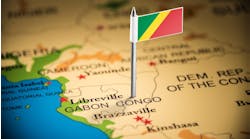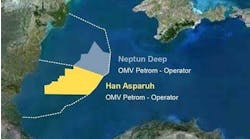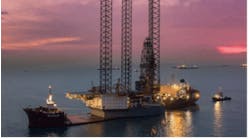How a JIP helped strengthen the moorings on Gulf of Mexico rigs
The 12 semisubmersible mobile offshore drilling units that went adrift during Hurricanes Katrina and Rita in 2005 caused neither pollution damage nor loss of life, but did blow a hole in industry’s comfort with existing MODU mooring criteria. It was not the first time a MODU had gone adrift in a storm, but it was the first widespread recognition that the consequences of mooring failure had changed.
A Joint Industry Project (JIP) on MODU Mooring Strength and Reliability, formed in response to the losses, has revolutionized industry understanding of Gulf weather, rig behavior, and development of mooring criteria. The results of that work, incorporated into new mooring criteria, will be presented at OTC 2009 in its first-ever conference session devoted entirely to the topic.
Before 2005, possibly the best-known mooring failure was that of the semisubmersible drilling rigZane Barnes, which broke adrift during Hurricane Andrew in 1992 and floated 30 mi (48 km) to shore, toppling one fixed production platform, colliding with another, and dragging anchors over several pipelines. Still, MODU damage during Andrew affected just a tiny fraction of Gulf production, which at the time accounted for barely 10% of US output. As such, it was soon forgotten. The US Minerals Management Service (MMS) did commission studies of rig performance during Andrew, but in the 40 years since the invention of the semisubmersible, such incidents were still rare and of minor consequence, so most experts tended to see mooring failure as an anomaly in a historically sound practice.
This was still the view in 2002, when one rig broke loose during Hurricane Lili. By then, however, the offshore had become critical to US oil supply, representing about 30% of domestic production – thanks largely to a few immense deepwater discoveries. With 72% of Gulf production now concentrated in a handful of deepwater platforms, and every deepwater advance encroaching on areas of MODU activity, mooring reliability fell under new scrutiny. The MMS, in commissioning a study of Lili’s effects on offshore production, specified MODU mooring analysis as one of the projects.
When Hurricane Ivan blew four semis off station in 2004, MMS increased pressure on industry for answers. The Gulf of Mexico Offshore Operators Committee (OOC) answered with its Hurricane Response Committee, a forum for operators and drilling contractors to share information. Seeing the issues needed broad industry involvement, the OOC issued a request for proposal for a JIP on MODU mooring strength and reliability. The RFP went out in June 2005, but as responses came in, so did hurricanes Katrina and Rita. Together with Ivan, the three storms sent a total of 16 MODUs adrift for varying distances, with another nine breaking lines or experiencing anchor slippage. None caused pollution or death, but all shouted a warning that could not be ignored.
Most of the rigs had broken free at the fairlead, while some tore free of the seabed and dragged their anchors while drifting. One dragged anchors across the 18-in. (46-cm) oil and 14-in. (36-cm) gas pipelines from the Mars production platform. At 147,000 b/d of output, Mars represents over 10% of total Gulf oil production, and damage to its export lines normally would cause a noticeable drop in US oil output. In this instance, however, the lines were repaired before the topsides damage, which shut in production from August until May. The MODU caused no pollution, but nonetheless made the new consequences of mooring failure unmistakable.
Immediately after the hurricanes, the government pushed for industry action, with then-Secretary of the Interior Gale Norton setting a date in November to discuss MODU safety with operators and drilling contractors. That September, OOC awarded the MODU JIP to ABS Consulting, in partnership with Delmar Systems, Offshore Risk & Technology, Energo Engineering, and Metocean, Coastal and Offshore Technologies. Quick response to the JIP enabled its representatives to bring to their meeting with the Secretary proof of over $1 million in funds and priceless expertise committed to its success.
Meanwhile, regulators and legislators began talking up a “no MODUs adrift program” and airing proposals to mandate Gulf semis keep station in a 100-year storm; some even proposed the criterion of a 1,000-year storm. The threat of such edicts raised critical safety and technology issues. One major concern was that most existing drilling rigs could not physically support the tremendous additional weight of chain and equipment such criteria would demand. The resulting fleet shutdown for upgrading would halt US offshore energy progress. There was also concern that 100-year criteria would endanger mooring installation crews, who would have to handle the much heavier chain and wire required while on the open deck of a rolling anchor handling boat. The JIP tackled the problem by reexamining the metocean data underlying current criteria.
New metocean understanding
“Before Ivan, Katrina, and Rita, I believe most people in the industry would have said that we know the waves and winds in the Gulf of Mexico pretty well, and that it was the loop and eddy currents that we needed to learn more about,” says Dave Petruska, an engineer with BP America Production Co. and chair of the API task force revising RP 2SK. “But Ivan, Katrina, Rita, and, more recently, Gustav and Ike, showed us that we did not know the metocean as well as we once may have liked to think we did.”
In fact, one of the JIP’s big discoveries was that the Gulf of Mexico has a number of distinct meteorological zones distinguished by storm severity. These presently are configured as East, West, West Central, and, the severest, Central. The improved and standardized metocean data it produced became the basis for a number of advances in industry knowledge and field practice.
The JIP was active for 18 months and delivered several landmark achievements. One was its critical input to API RP 95 F, the Interim Practice for Gulf of Mexico MODU Mooring, making the minimum design criterion for hurricane season at all Gulf of Mexico locations a 10-year return period event, with minimum design wind speed being 64 knots – meaning all MODUs should be able to resist a Category One hurricane. This was the significant increase in criteria that regulators had been hoping for.
“The minimum requirement we proposed for the Central Zone is a huge increase over the criteria used in the past,” says John Stiff, a senior consultant with ABS Consulting and among the JIP’s technical drivers. Not only did the actual metocean data change, but also the requirement increased to a 10-year return period. “In order to meet these new criteria the drilling contractors have upgraded their MODUs and have installed mooring systems that have probably doubled their return period capability.”
The JIP also established generic “default” data for each zone, to aid preliminary design of a drilling unit or be used in lieu of site-specific data. It also set criteria for developing site-specific data. The big change to the metocean data was not just that it became more severe, says Stiff, but that it also became far more organized.
“Data had been coming from multiple sources; there were no standards for its development; there was no requirement for data quality control; and there was no default data that was generally conservative for each area,” explains Stiff. “Today there are firm requirements on the metocean methodology supporting a mooring system, which helps to ensure consistency in design criteria.”
The new knowledge has been embraced by the metocean community and incorporated into the interim standards of API Bulletin 2-INT-MET, which is expected to soon become a full Recommended Practice (RP 2-MET) and eventually adopted into ISO standards.
Safely improving safety
Once the Gulf’s true weather conditions were identified, the risks and deficiencies in existing MODU mooring criteria could be named and ways to improve the rigs developed. Many in industry consider among the top JIP effects that rig moorings were toughened up without trashing existing chain and wire equipment or otherwise raising risk levels for the mooring installation sector. As a result of the JIP’s MODU Mooring Reliability Analysis, nearly all MODUs now working in the Gulf have upgraded from eight to 12 mooring lines.
“The deterministic mooring analysis quantified the current moored MODU fleet, which had not been done before,” says Evan Zimmerman, engineering manager at Delmar Systems and the person responsible for the JIP’s mooring analysis work. “This was critical, in my opinion, because it provided the industry and regulators the big picture on what the updated Gulf of Mexico metocean meant to the existing fleet. These results also quantified the benefit of different mooring configurations across the fleet and water depth ranges,” he explains. “The reliability mooring analysis and mooring failure investigation work also provided some valuable performance data on the existing MODU fleet. This work gave the industry a better handle on how well our design practices were and confirmed that Hurricanes Katrina and Rita were indeed extreme storms and overloaded the mooring systems.
“The moored MODU owners did an excellent job in increasing their mooring capabilities while not placing the installers in a situation that increases offshore safety risks during installation,” he notes. “The equipment selected was well chosen from current mooring component technology. The JIP also brought light to the benefit of polyester rope in catenary mooring systems and drove us and the other mooring installation contractors to increasing our rental inventories to be able to offer operators more choices in mooring configurations to optimize mooring performance on higher risk locations during hurricane season.”
Another milestone in the JIP’s risk assessment work raised awareness of the severe potential consequences of a rig breaking adrift. To address the issue, the JIP developed the industry’s first template for considering risk in deciding what wells to drill where and when. The 25 short-answer questions in its “MODU Risk Checklist” for the 2006 hurricane season yielded a “risk score” that could guide projects towards enhanced safety. Since 2006 it has evolved into the more detailed and complex “Enhanced Consequence Checklist” now in use.
The MMS closely tracked the JIP’s progress and praises its achievements.
“MMS and industry are now much better prepared to manage mooring risks during hurricane season, because mooring capabilities have been improved and effective risk assessment tools have been developed,” says an MMS spokesman. “These actions contributed to the improved performance of moored MODUs during hurricanes Gustav and Ike.”
“Through the JIP, a framework has been laid to use future hurricane events to assess the current initiatives,” says Petruska. “Now we need to bring in future events, in particular the failures, to validate the processes now in place. In the long haul, the plan is to not need a risk assessment for every site, but to be able to develop prescriptive design criteria. It will take analysis work like the JIP did to help set those criteria.”





